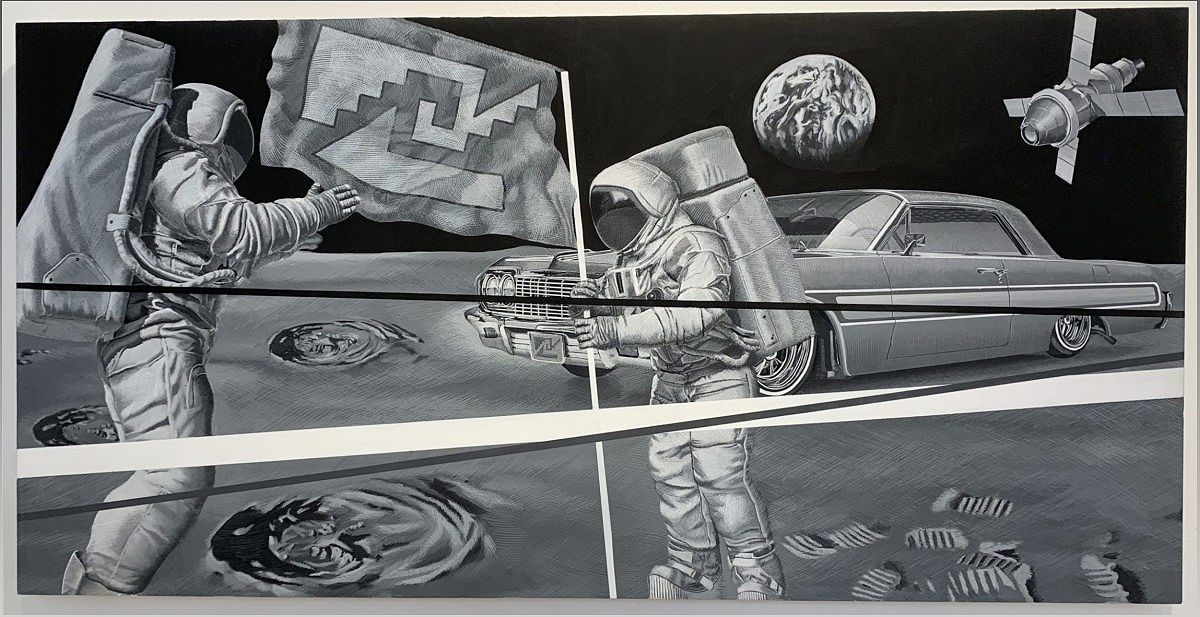Abel Alejandre's exhibition at Launch Gallery, titled 'The Chicano Moon Landing of 1968', offers a mesmerizing glimpse into an alternative history of the first moon landing. Through meticulously rendered paintings, Alejandre constructs a narrative that challenges the conventional account of this iconic event. Join us as we delve into the captivating world of 'The Chicano Moon Landing of 1968' and uncover the artist's thought-provoking exploration of identity, heritage, and the power of imagination.
Exploring 'The Chicano Moon Landing of 1968'
Uncover the captivating narrative and artistic techniques behind Abel Alejandre's exhibition.
Step into the world of 'The Chicano Moon Landing of 1968', where Abel Alejandre presents a thought-provoking alternative history of the first moon landing. Through meticulously rendered paintings, Alejandre constructs a narrative that challenges the conventional account of this iconic event. With a grayscale palette reminiscent of graphic novels, the artist creates a captivating atmosphere that draws viewers into his unique vision.
Alejandre's use of figurative imagery and abstract markings inspired by Pre-Columbian hieroglyphics and contemporary Cholo and Chicano writing adds depth and complexity to his works. These configurations represent the language of Xicanoland, an imagined civilization that emerged from the Chicano moon landing. The exhibition showcases Alejandre's exploration of identity, heritage, and the erasure of Indigenous histories from the annals of US history.
Unveiling the Fictitious Astronauts of Xicanoland
Discover the intriguing portrayal of Mexican American astronauts and their symbolic significance.
In 'The Chicano Moon Landing of 1968', Alejandre reimagines the iconic photo of Neil Armstrong and Buzz Aldrin planting the US flag on the moon. The fictitious astronauts are revealed as Mexican American, symbolized by the motif on their flag inspired by Indigenous architecture and warriors' shields. This powerful representation challenges the dominant narrative of the moon landing and celebrates the contributions of Mexican Americans to space exploration.
Alejandre's inclusion of a 1960s sedan, reminiscent of Chicano lowrider car parades, adds a touch of cultural context to the narrative. By blending elements of Chicano culture with the imagery of space exploration, the artist creates a rich tapestry that invites viewers to question the boundaries of history and identity.
Xicanoland: The Indigenous Empire's Crowning Achievement
Delve into the imagined civilization born from the Chicano moon landing.
Alejandre's narrative unfolds beyond the moon landing, revealing the birth of Xicanoland, an imagined civilization. This Indigenous empire, born from the Chicano moon landing, becomes the crowning achievement of Alejandre's alternative history. The artist combines abstract lines and calligraphic markings to represent the language of Xicanoland, infusing his paintings with spiritual energies.
The citizens of Xicanoland include Indigenous male astronauts depicted in heroic portraits. Alejandre pays homage to their ancestry, with one astronaut portrayed as a saintly figure with a Christ-like hairstyle. The artist's use of parallel lines and glowing light in the paintings 'Xolo I' and 'Xolo II' further adds to the mystical atmosphere, as hairless Mexican dogs known as Xoloitzcuintles serve as guardians of Xicanoland.
Reclaiming Indigenous Histories through Science Fiction
Explore the connection between immigration, Indigenous histories, and science fiction in Alejandre's work.
Alejandre's exploration of science fiction serves as a vehicle to delve into the complexities of being an immigrant in the United States. By creating an alternative history that celebrates the contributions of Mexican Americans and Indigenous cultures, the artist challenges the erasure of Indigenous histories from mainstream narratives.
The exhibition 'The Chicano Moon Landing of 1968' invites viewers to question the revisionist nature of US history and recognize the power of imagination in reclaiming marginalized narratives. Through his art, Alejandre highlights the importance of acknowledging and honoring diverse histories, ultimately fostering a more inclusive understanding of the past.

